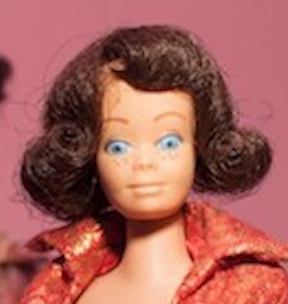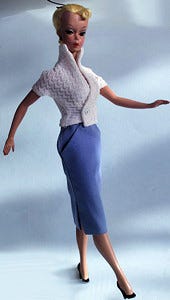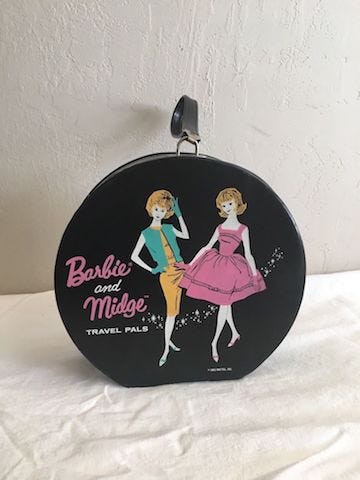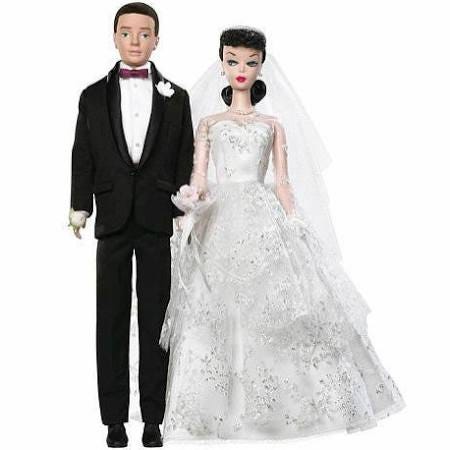From Our Pages: “Making Friends with Midge,” an essay on your best friend and Barbie’s. By Susann Cokal.
by broadstreetmag on Apr 25, 2015 • 11:49 am 1 Comment“Midge was, as all Mattel’s toys and books and marketing materials identified her, ‘Barbie’s Best Friend’— not simply herself. She never even had an essay written especially for her till now.”

The first Midge, with an early Ponytail Barbie. They are wearing versions of the Evening Splendor outfit.
Spend some time palling around with Midge, Barbie’s best friend, and Barbie fan/scholar Susann Cokal.
Besides being a literary critic, novelist, teacher, and Broad Street‘s editorial director, Cokal is a lifelong scholar of all things Barbie, with several pieces published on the subject. In this essay, Cokal explores what it means to be a best friend through the medium of Midge. Barbie’s best friend was invented to be a supportive character, but she’s had an interesting life of her own—including pregnancy and childbirth.
“Making Friends with Midge” originally appeared in the first issue of Broad Street, which is now out of print. This essay received a Special Mention in the 2015 Pushcart Prizes. It appears here for the first time specially formatted for online reading.
This essay was published in Broad Street Magazine’s first issue, “Dangerous Territory.” Citation: Broad Street 1.1, “Dangerous Territory“ (fall 2014).
*****************************************************************
Making Friends with Midge
Travel Pals
If you were a well-indulged little girl in the early 1960s, playtime confronted you with a couple of overwhelming questions. First, which of your slick-bodied, perfectly coiffed Mattel fashion dolls should be dressed for a party, which for a career? And second, when you and your friends were getting together to play, how could you carry around all those dresses and accessories, not to mention the multiple dolls who wore them? Would you choose your shiny black “Barbie and Midge, Travel Pals” carrying case,with its spaces for two dolls and a limited wardrobe — or, if you were particularly well-stocked, separate trunks for Barbie and “Midge, Barbie’s Best Friend”?
Perhaps you were heartless. Or too heartful. You might decide to pack the glamor up with your ponytailed Barbie and leave Midge smiling all alone in the case that identified her as Barbie’s bestie. After all, it wasn’t really Midge who was Barbie’s bff. That title belonged the little girl who combed her hair and readied her for “Evening Splendour” or an adventure “On the Road.” Yes, you were Barbie’s best best friend.

Poor Midge. Chances are that readers of today don’t remember her, or at least not the “real” Midge. Her first iteration was born in 1963 and gone by 1967.[4] She was barely a memory in my own growing-up years, a name whispered about but a face never seen. She didn’t have her own clothing labels — everything belonged to “Barbie by Mattel” — though she did share Barbie’s spectacular figure, which was stamped on the bum with both their names. Her original injection-vinyl face was wide-eyed and freckled, ready to tag along for fun, while Barbie’s was sultry, with downcast eyes and pouting lips. Midge was the unthreatening sidekick, the extra who reflected light on the star but never even dreamed of becoming an understudy. She was, as all Mattel’s toys and books and marketing materials identified her, “Barbie’s Best Friend” — not simply herself. She never even had an essay written especially for her.
“It wasn’t really Midge who was Barbie’s bff. That title belonged the little girl who combed her hair and readied her for Evening Splendor or an adventure On the Road. Yes, you were Barbie’s best best friend.”
Now, for Midge’s fiftieth birthday, it is high time to celebrate the supporting player who is crucial to any friendship. Midge, in her several incarnations, means friendship itself.
Best Friends
“Who’s your best friend?” Every little girl has been asked that question a dozen times. Mainstream American culture exerts tremendous pressure to pair off, not just heterosexually, but also with a same-sex friend who will be a long-term better half. Sharing secrets, sharing clothes, practicing kisses in front of each other (and in male fantasies)— harmless girl fun. It’s one of our childhood fantasies, even if a real girl’s best friend changes from one day to the next. “Will you be my best friend?” is tantamount to a proposal of marriage, and on every playground, at every recess, the question gets asked at least once.
Girls need female admirers. It’s a kind of romance separate from what most women have with men: someone who is very much like us recognizes the best in us. Only another girl (and I am writing primarily of heteronormative culture here) can truly understand and help us express our worth. Even into adulthood, women feel a need for a single person with whom to share every little experience and thought of the day. That sharing typically comes with an exchange of compliments, sympathy, and an underlying current of support and admiration, but danger always comes with offering up too much of the self.
“Girls need female admirers. It’s a kind of romance separate from what most women have with men: someone who is very much like us recognizes the best in us.”
My best male chum tells me that men don’t have best friends the way women do. Famous male pals such as Achilles and Patrokles, Roland and Olivier, seem mostly to have been comrades-in-arms, sometimes homoerotic, not quite symbiotic. I know one man who used to field those playground “Who’s your best friend?” queries by naming whichever kid his eye fell on first, even the drippy little nerd in the sweater vest.
A few years ago, at a destination wedding, I saw a little girl lounging in a hammock. She watched out of a pair of ethereal green eyes as some other children played in the dirt. When I saw her slender brown fingers fidgeting against each other, I recognized that her posture was misleading; she was tense, absorbed, and wary about what the other kids were doing.
Her mother was also watching. I sidled over and complimented her on her child — one of two ways women have of initiating social contact, the other being a comment on some article of clothing or jewelry.
The mother volunteered, with a degree of candor I hadn’t expected, “She has Asperger’s. She’s high-functioning, but she’s in third grade and she’s just starting to realize what Asperger’s means … She asked me the other day what a best friend is, and when I explained, she said she would probably never have one.”
So that was why the girl just lay there watching other children interact. She was absorbing the ways in which she wasn’t like them. As a lonely kid myself, I felt for her, an overwhelming sadness.
“She’s beautiful,” I said weakly. It was true; this little girl who was starting to realize that she was different in a way our culture did not celebrate, a way that in fact shut her off from that culture — she was like a Pre-Raphaelite painting of a sprite, too otherworldly to belong to the injection-vinyl Mattel family.
The mother just smiled and thanked me, acknowledging the truth inside that beauty with a sadness more profound than I could imagine.
Conception
The original Barbie, released in 1959, was based on a willfully sexy German doll for adults: a ponytailed strumpet called Lilli, from a cartoon series that ran in the newspaper Das Bild. Before Mattel executive Ruth Handler brought a Bild-Lilli back to the U.S. from vacation, little girls who wanted to continue doll play with fashionable clothing had been forced to graduate from vinyl babies to paper ladies. Handler’s idea was that a three-dimensional doll would allow for much more fun, especially with learning to dress a “real” body rather than a cardboard one. Handler pulled a Lilli out of her own travel bag and told Mattel’s other executives they were going make something just like her.
Nota bene: I do not intend to pass judgment on Barbie’s shape or face or what she’s done to the girls of the world. Her 11.5 inches of injection vinyl have done me nothing but good, as far as I can tell.

Barbie was copied from Lilli to a degree surprising in an age of international trademarks (in fact, Lilli sued Barbie, and Mattel purchased the Bild-Lilli copyright in 1961). Japanese re-engineers did soften her sexuality a bit, with bangs, lower eyebrows, a smaller forehead, and overall higher-quality, more pliant plastic. Handler was delighted, but the still-voluptuous figure (approximately 39–18–33), sultry eye liner, and pouting lips were considered too much for little girls: Barbie bombed her first toy fair in 1959. Many stores, including Sears, refused to stock the very first dolls … until summer vacation and TV advertising produced hordes of little girls clamoring to pay a pricy $3.00 per unit, plus up to $5.00 for hand-finished outfits like “Some Enchanted Evening” and the pink taffeta-and-velvet “Sophisticated Lady.” They took the retail world by storm and made Barbie a must-have. Even today, with fierce competition from Bratz and other dolls of roughly the same size and purpose, Barbie and her friends get their own dedicated bright pink aisle at Target and other popular stores.
“Barbie looked much more experienced than a middle-class parent wanted a sixteen-year-old to be. Hence unsexy Midge was conceived.”
Part of Barbie’s endurance has come from careful positioning within a world of “real” careers. The 1959-to-1967 Barbie was officially known as a “teenage fashion model,”but she had outfits corresponding to numerous diverse jobs — artist, fashion editor, American Airlines stewardess, and blue-caped Registered Nurse, along with innocent pinafores for “Barbie Baby-Sits” and capri pants for Friday night dates and weekend road trips. Still, concerns about that sexy body and pouty face lingered. Barbie looked much more experienced than a middle-class parent wanted a sixteen-year-old to be.
Hence unsexual Midge was conceived and introduced to the world in 1963, followed by Barbie’s flat-chested little sister, Skipper, in 1964 — somewhat in the way that modern-day parents conceive a second child to be a bone-marrow donor to a first child with leukemia. Other friends and family members came along in the fullness of time (Christie, Francie, P.J.), but they were all, however distinctive in their own ways, further versions of that original bff, Midge.
Midge had the same body as the classic Barbie, but her face was unthreatening. She was, quite frankly, plain-looking — and she smiled about it. Her homely, open face gave credence to Mattel’s claim that the Barbie/Midge body had to be shaped the way it was so that bulky waist seams, buttons, and metal fasteners wouldn’t make the doll’s figure look out of proportion; fully clothed, that is, Barbie supposedly looked like an ordinary teenaged girl (a few playtime experiments and photographs will easily falsify this claim). Midge was truly the all-American girl whom Barbie purported to be. She made the whole line less threatening — and yet, by contrast, she inadverently heightened Barbie’s pouty sensuality.
Midge’s birth announcement came in the mini-catalogues that accompanied some merchandise. Her launch description declares that “Barbie’s Best Friend” is “ ‘the girl next door,’ now available. Midge finds Barbie’s lovely clothes a perfect fit, too. Sturdy, flesh-tone vinyl plastic and polyethylene with movable arms, legs, and head.” The message is clear: Midge gets to wear Barbie’s clothes (and her freckled nose and bubble-flip hair style are featured in some nice ones), but the clothes don’t belong to her.
Though the description is almost identical in “Your Barbie doll is created of sturdy flesh-toned vinyl plastic,” the slightly altered wording creates a closer bond with the little-girl consumer: This is your Barbie doll, your best friend; Midge lives next door and borrows Barbie’s clothes. She is the interloper in your relationship with your Barbie.

Falling in Best
Finding a best friend is much like falling in love, and as tricky and dangerous. The urge to spill all one’s secrets to someone else is accompanied by an “Omigosh, I can’t believe this fabulous woman wants to tell her secrets to me,wants myopinion on which to dress to wear.” There’s always an element of Barbie and Midge. If Roland Barthes is correct, and the lover’s fatal identity is that he is the one who waits, then we might say that the best friend’s identity is that she is the one who Midges.
Secrets are, of course, secrets, and at first we remain as tight-lipped about them as manikins of injection vinyl. But shopping and choosing outfits, so often the subject of jokes that poke fun at femalehood, are a safe part of the bonding process. Wherever a girl or woman lives, she feels pressure to find one person to shop and dress up with, just as in those old days of doll play. Dressing ourselves is how we define who we are to each other and determine whether our self-images are compatible, and whether we can trust a friend with secrets greater than preference in blouses.
For one of my first “dates” with my high school bff, Leslie, we watched the county fair parade (small town). Businesses along the main street were having a sidewalk sale, and we browsed the racks. Though we had and still have very different tastes, we both picked up a teal-colored blouse — teal being then, as now, Leslie’s favorite color, and I being eager to please. As one, we looked at the frayed seams and pronounced, “Shoddy.” A friendship was born.
“We might say that the best friend’s identity is that she is the one who Midges.”
The best friend I’ve had in every place I’ve lived has represented some aspect of myself that I wish were better developed. Leslie is brilliant, taking college calculus as a junior in high school, and she became a doctor to work with indigent populations in New Mexico, rather than succumbing to the siren-song of a paycheck. Marjorie was the most popular girl in my creative writing program and has the happiest marriage I’ve ever seen; she’s so big-hearted that when my father died, she insisted on coming to New Mexico to help untangle his messy estate. And at my first “real” job, Trixie was the spunkiest, most admired, favorite teacher, and the girl most capable of having a great time just shopping for paper goods at Target.
I’ve been flabbergasted each time one of these women has called me “her personal best friend,” “the sister I never had,” or “the sister I’ve always had.” Or even said, “You’ll be the most sophisticated person at my wedding,” when I’ve felt anything but. They’re all my Barbies; I’m surprised that they’d see me as anything but a trying-so-hard, feeling-so-keenly Midge.
And yes, we may accessorize differently, but we shop together well.
So what does Barbie get from having a Midge? She gets security, of course, knowing there’s something she brings to the travel case that Midge can’t. But in their secret hearts, Barbies might see something in Midges that they themselves don’t have. What could it be?
Barbie v. Midge
The original Midge was not Barbie’s rival. She was never meant to be. Her sales didn’t come close to Barbie’s numbers, which was the way Mattel wanted it. Midge was one of those sweet, supportive, always admiring friends from idealized stories for girls: She was Diana Barry to Barbie’s Anne of Green Gables; Bess and George to Barbie’s Nancy Drew, Melanie to Scarlett, Harriet to Emma Woodhouse.

What little we might know about Midge below the flesh-toned surface comes from a Mattel-sponsored magazine and a series of books written under noms de plume such as Cynthia Lawrence and Bette Lou Maybee: Here’s Barbie; Barbie Solves a Mystery; Barbie, Midge, and Ken. In the fiction, pretty, perfect, and practical Barbie is the girl everyone wants for a best friend. Midge is the girl everyone is.
The books were never as successful as the dolls and accessories themselves; girls naturally wanted to channel their own stories into those vinyl bodies. But the novels and short stories give a good briefing for how Mattel saw the individual personalities and, thus, how girls were expected to play. In stories like “‘A’ is for Allan,” “Three on a Ski,” and “She’s a Jolly Good Fellow” (all from the 1964 anthology Barbie, Midge, and Ken), Midge has a “round, freckled face” and “was not a silly girl but plunged into every situation with all her heart.” She is quite a chatterbox, except around boys she really likes, and she tends to run late — unlike Barbie, who is so very generous, reliable, and kind of spirit that she gives up part of her Christmas to take care of an old family friend.
Handler once said that she didn’t want to define Barbie’s character: “through Barbie each little girl could project her own personality.” Nonetheless, the books present the sturdy Barbie of the catalogue description, with open-eyed illustrations and a cheerful smile worthy of a nineteenth-century Angel in the House. But Mattel’s leading lady is still, of course, confident in her sexual allure, and in the stories she grows gently exasperated with Midge’s blushing clumsiness, lack of self-assurance, and susceptibility to crushes on boys other than the one designed for her: red-haired and similarly freckled Allan, introduced in 1964.
Yes, vintage Barbie was pretty close to perfect, and it was nice of her to hold Midge so close. “Poor Midge,” Barbie reflects as her best friend pines over her carrot-topped future boyfriend. “She felt everything so keenly.” Don’t we all? And don’t we long to feel in a Barbie sort of way, in which we can afford to be generous to those less fortunate because we are so sure of our own lives and selves? Failing that, we’ll take Barbie’s sympathy.
Midge was useful because she could do things Barbie couldn’t. Married. Had a baby. Had a big detachable pregnant belly with a baby inside. In short, looked plain, lost her virginity, lived the life of a mother.
Sometimes, with special girls, Midge won hearts of her own.
“I played with my mom’s vintage dolls, and I always went for Midge,” says my friend Claire, who is a couple generations younger than the first Mattel fashion dolls. “She seemed more relatable, like she really would be my friend.” Claire went out of her way to snag the best outfits for her mother’s Midge, not for Barbie; Midge really was her bff. As an adult, she made a photo essay about Midge’s adventures around the apartment and mounted it on MySpace.
Claire is a well-adjusted young woman.
“Poor Midge,” Barbie reflects as her best friend pines over her carrot-topped future boyfriend. “She felt everything so keenly.”
Sometimes, with special girls, Midge won hearts of her own.
“I played with my mom’s vintage dolls, and I always went for Midge,” says my friend Claire, who is a couple generations younger than the first Mattel fashion dolls. “She seemed more relatable, like she really would be my friend.” Claire went out of her way to snag the best outfits for her mother’s Midge, not for Barbie; Midge really was her bff. As an adult, she made a photo essay about Midge’s adventures around the apartment and mounted it on MySpace.
Claire is a well-adjusted young woman.
A Secret Aside
I, too, am a chatterbox, I feel things keenly, and I want to be your sturdy friend. I am going to offer up my own fashion-doll secrets now, in the hopes that you, dear reader, will find me worthy. Let this be our moment of shopping together.
I used to have a big family of Barbies, or so I called them. Most were lightweight imitations from Taiwan, or smaller models from the now-defunct Topper company, who had names like Dawn and Angie and were built like Barbie but half the size. I always longed for real Barbies, for the heft of Mattel-level quality and the shine and glamor of the original gowns, but as a kid, I worked with what I had. The mother of my brood was a Francie, “Barbie’s MODérn cousin,” a new arrival of 1966[26]whose Twiggy-thin body was designed for the second Mattel generation and acceptable to my father, who at first refused to see his daughters playing with the more topheavy models.
My Francie was best friends with my sister’s Francie, even though my sister (in an act of sororal hostility but friendly generosity) had switched my carefully tended doll for her own bff’s battered version less than a year after we got ours.
I immediately knew on some level that my Francie was an impostor; her face was faded and scarred with toothmarks, her hair raggedly cut. Dad had to use a special glue to reattach her right foot. But though I still mourn that original, perfect Francie, I on some level have always known that the battered substitute was the right one for me. She needed my care. I promised her I’d always give her sewn outfits, not scraps of fabric wrapped around her body with ribbon. I let her be the mother to the motley assortment of Toppers and odd little Danish dolls sent by my grandmother, all of whom adored her.
I let her be, in short, both Barbie and Midge … and me. I took care of her as I would have taken care of myself, if I had been a Barbie.
“No matter how we come to embrace our inner Midge, we all have a bit of Barbie waiting to take over.”
That faux Francie encouraged me to become a novelist. Barbie’s mutilated cousin was the object of my seamstressing and complicated storylines; she helped me work out emotional dilemmas until I was ready to go to college. Yes, college; that’s how long I stayed engaged with doll play. Now Francie’s family lives stacked together in a box in my basement, and Francie — my personal Midge — rests at the top, where she can breathe.
It’s not that I’m ungrateful to her. I have grown up and away from that ragged family, but the Mattel line stays with me in my fiction (a Barbie in every plot) and in my home decor. I have some lovely vintage models displayed on a “story shelf” upstairs, where my cats sometimes rearrange them and visitors almost always comment on the couples I’ve arranged — a few of my Kens are gay, and not every Barbie has a mate. A couple of the rarer specimens stand on the parlor mantel with my grouping of antique Virgin Mary statuettes. They are a #3 Barbie and a first-edition Midge, wearing lamé cocktail ensembles identical but for their color. They are the perfect couple, one face sultry and one eager, both dressed to the nines.
Yes, I suppose I have chosen to show the world my most glamorous best friends, rather than my homeliest ones. I bask in the light reflected off their lamé, and I become Barbie-er even while I honor my Midge.
Midge into Barbie
No matter how we come to embrace our inner Midge, we all have a bit of Barbie waiting to take over. Claire, who favored Midge as a child, loves to dress in fantastic gowns custom made by her clothing-designer roommate. She also dyes her hair as often as a Barbie Fashion Queen changes her wig, and she struts her roommate’s runway with a toss of colored locks and glittering skirts.
If Claire were a serious collector of the Barbie line, she would attend a convention and fashion show or two a year. These are happy, celebratory events where doll lovers of assorted genders, shapes, and ages gather to sell, exchange, talk about, and dress like Barbie. Always Barbie, rarely Ken; never Midge. During the fashion shows that are the capstone experience of most conventions, fans make their own life-sized copies of the best-loved outfits, fasten their hair back in the signature double-tiered ponytail, and strut the stage in “Solo in the Spotlight” or “Plantation Belle.”
The crowd goes wild.
There might be ribbons for first and second place, but everybody, however asymmetrically shaped the body or cheaply made the outfit, is a winner. Everyone is a best friend. Hundreds of Midges watch each other transform into Barbies onstage.
Makeovers and Happy Families
For the original Barbie and Midge, female acclaim was just about all they needed. Cartoon-faced boyfriends Ken and Allan were mere accessories to their lives as friends. Ken appeared just before Midge, to fill out Barbie’s world, but Barbie still needed her bff; Allan was an afterthought in 1964, so Midge could have a boyfriend of her own. (Fun facts: Barbie was named after Ruth Handler’s daughter, Barbara — who married a man named Allen in 1959. Ken, Barbie’s boyfriend, was named after Handler’s son. How tangled is the Barbie family!)

As early as 1959, wedding gowns were made. Barbie did put them on, and she even modeled them in the catalogues … but Barbie and Ken were in a permanent holding pattern while Barbie pursued those fabulous careers with the detailed outfits and hefty price tags. Barbie tied down — unthinkable! She had too much to do with her life, too many possibilities; despite her sex-goddess origins, she had to stay virginal and full of pure potential. So eventually it was Midge’s wedding that Mattel announced. Perfect: Girls could carry out their wedding dreams and keep their most aspirational toy still firmly rooted in the world of career dreams.
Around 1967, in the midst of a product line overhaul, Midge and Allan disappeared from the Mattel family. It’s not that Barbie and Midge broke up (Barbie is no Mean Girl), more that they grew apart: In a changing world, with new characters coming in, Midge’s uncertain identity and her exclusive friendship with the star doll were indeed fatal. Barbie’s new face came with open eyes and a smile: she had taken on a certain Midginess of her own, and the company didn’t grant her a single bff anymore.
Only after a lengthy hiatus did Barbie and Midge’s friendship reemerge, in the late 1980s — and a few years later, Midge rocked the toy world.
Midge’s reincarnation came in a new body, smiling, slender, with Francie-like breasts (a more modest size also adopted by Barbie in the last decade). At first, made-over Midge drifted from one job to another, trying her luck as a backup singer for Barbie, but she was very much a backup figure with no career of her own. Married life was still the clear right choice for her. Thus she was married off to Alan (note the missing “l”) in 1991 and sold as part of a “Wedding Day” set.
In 2003, she settled into Yuppie motherhood. She had long red hair with a few braids twined in, and earth-mother shoes. And she was pregnant.

That sweet tag-along chatterbox! O, how the years had changed her!
Midge was living an old-fashioned dream as the focus of a “Happy Family” toy series. The baby who came with the set was adorably tiny, diapered in either blue or pink, and easily hidden in a magnetized hard-plastic belly. In her very first “Happy” set, one thing was missing: a wedding ring. Parents were outraged, much as they’d been with 1959 Barbie; Wal-Mart refused to stock the dolls. Was pregnant Midge encouraging teen intercourse? Unwed?
Mattel quickly corrected the omission; of course the girl next door had been married when she conceived.
But ring or no ring, to adult consumers, pregnant Midge was still eerie. And to girls, she was fascinating. Claire says she begged and begged for a pregnant Midge when she was little, but her parents weren’t comfortable with the whole dolls-giving-birth-to-dolls thing, so she got the rocker Midge instead. At a time when “We Girls Can Do Anything,” as the Mattel slogan once ran, being a rock star was ho-hum. The exotic and forbidden was becoming a stay-at-home mom … though the controversial nature of the “Happy Family” means it is now gone from the shelves.
“Mattel quickly corrected the omission; of course the girl next door had been married when she conceived.”
For my generation, which falls between Claire’s and her parents’ — a generation that grabbed up lamé evening gowns for doll play but insisted on careers for women, often before employers implemented family-friendly policies — “Happy Family” Midge is a fulcrum for latter-day feminist curiosity. Recently, after a decade of resisting temptation, I finally ordered my own pregnant Midge for the purposes (honestly!) of research. I had to know how a slim plastic doll could give birth; my childhood Francie’s family had just sprung into being, and a family of my own never happened. When the box arrived, I was intrigued to find that pregnant Midge has flexible hips for birthing and is easily posed for the act. Yes, I have arranged Happy Family Midge with knees up and baby in position, and she handles it very well. Her elbows also bend for holding her tiny baby. She looks undeniably … sweet. She makes me a little weepy.
Periodically she visits white-coated Doctor Barbie, who was designed as Midge’s pediatrician and comes packaged with two extra babies to treat. As ever, Barbie is the one with the career; she gets to run things, gets the ultimate say over Midge’s body. We girls can do anything, but the alpha gets a professional identity.
Is there anything odd about having your bff as your OB-GYN? Well, I did once get an annual exam from my high school friend Leslie. The appointment reanchored all sorts of hierarchies; she was the one with the skills, I was the one with the potential problem. And I was relieved she knew what she was doing.
Midge soon disappeared with her babies, to resurface only in 2013. Or so it is rumored; I haven’t been able to find her latest incarnation, as the toy stores seem to stock more exotically named friends like Kiera, Nikki, and Lea — ballerinas, fashionistas, mermaids, bikini babes. I’m curious, to say the least, about who Midge might be now.
Going Too Far, Getting Too Barbie
In adulthood, friendships grow less plastic; they settled in. Only a significant life change will rearrange friendly identities, and the reconfiguration can endanger sense of self — even as it would in the teen years.
So. One year, a grad school chum was going through some of those life changes (a breakup, a new job) and wanted company on a trip to Arizona. In mid-July. No one else was willing to brave the location and the season, so she needed me, her best friend. One quality that remained constant with this woman was her enthusiasm for giving advice and analyzing her friends’ personalities. I recognized that she was judgmental, yes, but that was part of her allure — when one is young(ish), anyone with a harsh opinion seems worth winning.
So there we were, Tucson in 114-degree heat, and she told me something I did not expect to hear. I shared a secret about an overattentive male co-worker, and she threw up her hands as if I’d told her “ ‘A’ is for Allan.” According to this woman, I oozed sex, I flirted to cover my shyness, and nobody knew how to relate to me other than as a sex object. It was my own fault if I was having problems; by my very personality, I’d brought it on myself.
She had no access to my well-buried personal dictionary, but there was the fact: She had condemned me. I was not just Barbie; I was the Bild-Lilli Barbie. Not the career Barbie but the sexy one, the prototype who was only sexy.
I couldn’t be that person, any more than I could be “Happy Family” Midge. So I got up. I left Tucson and the friendship, though I decided to use the time before my plane ticket expired to rent a car and drive around the state. I saw places my parents had courted each other and conceived me, also doing research on the old mines, Tombstone, and crystal-studded caves for a novel I was then writing.
The great irony, and the evidence that there is some plan to the universe’s games, is that when I checked into a brand-name hotel, the clerk made me sign a document promising not to engage in illegal activity. Weird, but this was conservative Arizona. I discovered what that signature implied about an hour later, when the hooker in the room next to mine started up her night’s trade. Men began knocking on my door by mistake. As a single woman (no Happy Family in sight), I’d been put in the prostitution section of the Comfort Hotel, and the management would not be held liable for my sexual activities.
That night, while strangers tapped on my door and tried to peer through my window, my friend-heart shattered, not made of plastic at all. I cowered tense on my bed, afraid to fall asleep, to touch the sheets, to try to leave. Midge should not be cast in a Barbie role.
But in the week that followed (during which I stayed alone in a haunted Victorian hotel, and in an assortment of Motel 6’s), my Midge and Barbie components came together. As I mourned the end of a friendship, I constructed the core of my novel, combining prostitution with railroads, gold digging, and the quest for a lover-accessory who will see the heroine the way she wants to be seen.
Is that as Barbie or as Midge?
Both. At least, in their vintage versions.
Happy fiftieth birthday, Midge. Thank you, sweet and constant bffs everywhere.

******************************************************************

susanncokal.net.









